Abstract
High calcium waste dust from asphalt concrete manufacturing was utilized to stabilize low-quality lateritic soil as a subbase course material in road structures. Asphalt waste dust up to 30 percent by weight (wt%) was incorporated into the solely lateritic soil and the mixture of lateritic soil containing 5 wt% Portland cement. The asphalt waste dust was successfully used as a subbase course material in road structures according to the standard specifications of pavement materials issued by the Thailand Department of Highways. The minimum 20 wt% asphalt waste dust induced a sufficiently high California bearing ratio, optimized plastic index, liquid limit, and swelling index of soil above the minimum standard requirements for a subbase course material. The fine particles of asphalt waste dust showed filler-like properties to reduce the voids and generated a very dense surface in the stabilized lateritic soil samples. With the small content of cement mixes, a decrease in the calcite phase in the soil stabilized with asphalt waste dust indicated a partial promotion of CaCO3 from the asphalt waste dust in the cement hydration reaction. The very high strength (CBR > 250%) of these stabilized soil samples approached the standard for base course material (CBR ≥ 80%), which was beyond the expectation for the subbase material (CBR ≥ 25%). Thus, recycling-waste dust from asphalt concrete manufacturing can be used as an effectively sustainable subbase course and base course materials in further generation for road construction purposes.
1. Introduction
Asphalt concrete containing aggregate and bitumen is widely used as a pavement material for road construction. “Asphalt Waste Dust” is highly produced as a byproduct or waste at every single production site of asphalt concrete. In the plant mix, the different sizes of stone are incinerated at 150–170 °C before being mixed with liquid asphalt to produce ready-mixed asphalt concrete. This results in residual dust from the asphalt concrete manufacturing process. According to the Department of Highways, asphalt concrete plants are typically found 100 km or less from the sites of road construction. As a result, there are numerous asphalt concrete plants located throughout the entire country, and a substantial amount of leftover asphalt waste dust from hot-mixed asphalt concrete is not currently being used for any other purposes. In addition, the disposal of asphalt waste dust normally uses landfills, which require a large area and subsume high costs to eliminate this abandoned dust.
In order to use a large amount of recycling asphalt waste dust, the construction sector offers a large opportunity to use such asphalt waste dust in road construction. The subbase course is one of the structural support layers in the road structure. According to the standard specifications from the Thailand Department of Highways, the California bearing ratio (CBR) is the main criterion used to select the subbase course materials for road structure [1,2].
Nowadays, lateritic soil is used as a low-cost subbase course material in road structures. Since the natural lateritic soil does not possess all the desirable qualities, a stabilization technique is required to increase its properties to achieve the minimum requirement of the standard specifications. Chemical stabilization is applied to improve soil strength [3,4,5]. Portland cement is the most common additive in the soil to increase the strength of the base in the chemical stabilization technique. Stabilization by cement addition normally depends on the cement content, water content, and curing time [6,7]. Reports on the stabilization of lateritic soil with cement in terms of CBR value have been conducted by many researchers. It was found that the additions of cement in the ratio of about 5–7 wt% were the most effective ranges to develop the CBR of lateritic soil due to the obtained maximum dry density of the cement-stabilized lateritic soil [8,9,10,11,12]. These results were also obtained via a drawback effect on the CBR when the cement above 10 wt% was mixed into the stabilized lateritic soil [13].
Several additive materials, such as lime, fibers, fly ash, etc., were also used in soil stabilization by many researchers. The additive contents were relatively varied, depending on the characteristics and chemical properties of each additive material. Fly ash is one of the well-known additive examples in soil stabilization. It was typically used in the range of 0 wt% to 30 wt% in stabilizing expansive soil [14,15,16]. This was because the high content of fly ash strongly decreased the liquid limit, plasticity index, swelling, and maximum dry density values of the soil, whereas the CBR gradually increased.
Asphalt waste dust from asphalt concrete manufacturing is another industrial waste that has attractive characteristics as an alternative additive material for soil stabilization. In our preliminary study, the asphalt waste dust had fineness and a relatively high content of calcium oxide (CaO) in the form of limestone (CaCO3) as a major component as analyzed using an X-ray diffraction technique. Since we found no previous report on the effective use of asphalt waste dust, a similar material such as natural limestone was considered as a reference. As opposed to its use in natural soil, the use of CaCO3 in cement mixed materials has been widely reported [17,18]. The replacement of cement with 10–15 wt% CaCO3 was found to be effective in improving the early strength, reducing the setting time, and providing workability of the cement mortar and concrete. This was attributed to the filler-like properties of fine CaCO3 existing in the cement-mixed samples. This resulted in a reduction in voids in the cement-mixed samples, while at the same time, the hydration reaction was accelerated between adjacent cement particles. Thus, the CaCO3 components in asphalt waste dust probably could assist in promoting the strength of soil–cement samples in a behavior similar to that of the CaCO3-mixed cement material in the aforementioned studies. That means that asphalt waste dust could be a novel additive filler in soil stabilization that would offer a higher sustainability performance in terms of cost savings and resource conservation, especially in future generations for construction purposes.
Since road construction requires high-quality materials, location is one of the crucial choices when selecting construction materials with minimized transportation costs. Many asphalt concrete plants located near road-construction sites in the entire country could serve this purpose in the selection of recycling materials such as asphalt waste dust. Therefore, this study aimed to assess and demonstrate the incorporation of asphalt waste dust into a soil–cement mixture in order to increase the overall performance of the low-quality lateritic soil used as a subbase course material in road structures. Asphalt waste dust in the range of 10 wt% to 30 wt% was selected in this study, following the common range of other additives from earlier works on soil stabilization. The asphalt waste dust was added into the solely lateritic soil and the mixture of lateritic soil with 5 wt% Portland cement. Furthermore, the materials testing under the standard specifications of pavement materials from the Thailand Department of Highways (DOH) was carried out on the prepared samples, and the performance of asphalt waste dust related to the basic chemical and mineral component and microstructure of the stabilized-soil samples was discussed. The replacement of lateritic soil with asphalt waste dust for construction purposes could potentially offer economic, social, and environmental benefits.
2. Materials and Characterizations
Lateritic soils are classified by the grain size distribution ranges into five grades: A, B, C, D, and E, according to the American Association of State Highway and Transportation Officials (AASHTO) criteria and the standard no. DH-S 205/2532 [19] of the Thailand Department of Highways (Table 1). The classified series are from the best properties with high maximum dry density and high California bearing ratio (CBR), but the lowest optimum water content value (grade A) [20], to the poor properties of dry density, CBR, and optimum water content (grade E). In this research, the lateritic soil was obtained from Chachoengsao province, Thailand. The lateritic soil grade E was selected for this research because it has the lowest mechanical properties that need to be enhanced. The grain size distribution of the lateritic soil was determined by sieve analysis before preparing the lateritic soil grade E (Mixed E in Table 1). The percent passing through a 25.00 mm sieve, 2.00 mm sieve, 0.425 mm sieve, and a 0.075 mm sieve of the lateritic soils were 100 wt%, 74 wt%, 20 wt%, and 6 wt%, respectively (Figure 1a and Table 1).

Table 1.
Grain size distributions of subbase course classification by the Thailand Department of Highways [19].

Figure 1.
Materials testing (a) Lateritic soil (Grade E) (b) Asphalt waste dust (c) Mixing samples of Lateritic soil (Grade E), asphalt waste dust and Portland cement.
Asphalt waste dust shown in Figure 1b was obtained from the asphalt concrete plant at Nakhon Ratchasima, Thailand. Asphalt waste dust was prepared by sieving through a 40-mesh sieve in which the particles were smaller than 0.42 mm. Ordinary Portland cement (OPC) Type 1 was utilized at a low concentration of 5 wt% in a mixture of lateritic soil and asphalt waste dust (Figure 1c). Laser particle size analysis using HORIBA Partica LA-950V2 was used to determine average particle size and distribution size. Atterberg’s limits tests, including plastic limit, liquid limit, and plasticity index, were carried out on the lateritic soil and asphalt waste dust. The chemical composition of raw materials was determined using Energy Dispersive X-ray Fluorescence (EDXRF) Horiba XGT-5200 X-ray Analytical Microscope. The mineral composition was examined by Bruker D2 PHASER X-ray diffractometer (XRD) with Cu-Kα radiation over the 2θ range of 20–50°. Morphology of the asphalt waste dust was examined by JEOL JSM-6010 LV scanning electron microscopy with energy-dispersive X-ray spectroscopy (SEM/EDS Oxford Instrument X-MaxN, Oxford, UK).
3. Testing Methods
3.1. Testing Conditions
This research was performed under the replacement conditions in the soil–cement stabilizing technique to understand the effect of asphalt waste dust stabilized the lateritic soil mixes. Asphalt waste dust was mixed into lateritic soil containing 5 wt% Portland cement. The efficiency of asphalt waste dust in an increment of the strength of the natural lateritic soil containing a small portion of Portland cement was investigated. The testing conditions were divided into 8 conditions (Table 2), and the names are as follows:

Table 2.
The 8 conditions of testing samples.
- (1)
- LS refers to ordinary lateritic soil.
- (2)
- AD refers to pure asphalt waste dust.
- (3)
- 90LS-10AD refers to LS of 90 wt% mixed with AD of 10 wt% of dry LS sample.
- (4)
- 80LS-20AD refers to LS of 80 wt% mixed with AD of 20 wt% of dry LS sample.
- (5)
- 70LS-30AD refers to LS of 70 wt% mixed with AD of 30 wt% of dry LS sample.
- (6)
- 90LS-10AD refers to LS of 90 wt% mixed with AD of 10 wt% of dry LS sample and added 5 wt% Portland cement.
- (7)
- 80LS-20AD refers to LS of 80 wt% mixed with AD of 20 wt% of dry LS sample and add 5 wt% Portland cement.
- (8)
- 70LS-30AD refers to LS of 70 wt% mixed with AD of 30 wt% of dry LS sample and add 5 wt% Portland cement.
3.2. Compaction Test
Dry density and water content of LS, AD, 90LS-10AD, 80LS-20AD, 70LS-30AD, 90LS-10AD-5C, 80LS-20AD-5C, and 70LS-30AD-5C samples were determined by the modified proctor compaction (AASHTO T 180) [21] to obtain the maximum dry density and the optimal water content of those samples. The optimal water content was subsequently used for California bearing ratio testing.
In the sample preparation process, arbitrary amounts of tap water (five different amounts for each sample) were added to the samples and manually blended until the homogeneous color and texture were obtained. Then, five equal amounts of each mixture were transferred to cylindrical molds with a diameter of 152.4 mm in sequential order (to the top surface mold). Each layer of those samples was compacted 56 blows, using a 44.48 N hammer dropping from a height of 457.2 mm, equivalent to 2700 kN-m/m3 compaction effort (approximately 4.5 times of the standard proctor test). The compacted sample molds were weighed before ejecting the samples from the molds. The ejected samples were dried overnight in an oven before determining the optimal water content at the maximum dry density.
3.3. California Bearing Ratio
According to the AASHTO T 193 standard [22], the California bearing ratio (CBR) under soaked conditions and swelling indexes of LS, AD, 90LS-10AD, 80LS-20AD, 70LS-30AD, 90LS-10AD-5C, 80LS-20AD-5C, and 70LS-30AD-5C samples were determined. The CBR describes the strength of the materials in comparison to the bearing capacity of well-graded crushed rock with 100% CBR at the maximum dry density. Before the penetration test, the swelling behavior of those samples was also characterized under soaking conditions for 96 h (4 days). The soaked condition was used to simulate the worst-case scenario of the fully saturated region after flooding.
Each sample was uniformly blended in the tap water during the CBR test under soaking conditions at the optimal water content ratio determined by the compaction test. Five equal portions of each soil sample were sequentially put into each of the three cylindrical molds, with an inner diameter of 152.40 mm and a height of 177.80 mm. In those three molds, the transferred soil sample was compressed with 12, 25, and 56 blows for each layer, respectively. The samples were submerged in the water and then taken out of the water tank. The samples were dried for 15 min before being loaded axially with 50 kN maximum capacity and 1 × 10−5 to 6.00 mm/min speed using the penetration test machine (CONTROLS Triaxial tester T400 Digital, Model MUL125, Ser.no. 610910 by K. Thaithamrong Engineering LTD., Pathumthani, Thailand).
During the penetration test, a 4.54-kg surcharge weight (two pieces of 2.27-kg circular discs) was placed on top of the soil sample surface. The penetration was carried out at a rate of 1.27 mm/min using a steel penetration piston with a 49.63 mm diameter that was attached to the proving ring through the center. The load measurements for the deformation depths of 0.64 mm, 1.27 mm, 1.91 mm, 2.54 mm, 3.18 mm, 3.81 mm, 4.45 mm, 5.08 mm, 7.62 mm, 10.16 mm, and 12.70 mm were taken. To determine the water content at the top layer of the soil samples, the soil samples were taken out of the molds. Equation (1) was applied to convert the load and deformation at 5.08 mm-penetration depth under saturated conditions into the CBR of the soil samples. The obtained CBR was compared to the standard CBR (10.30 MPa) of the standard crushed rock at the same penetration depth.
CBR (%) = (Test unit load/Standard unit load) × 100
The soil samples in the mold under loading with a 4.54-kg surcharge weight were submerged for 96 h (4 days) prior to the penetration test in order to analyze the swelling behavior of the samples and simulate flooding damage. The swelling index after 96 h-submersion was calculated using Equation (2), in which the initial height of the samples was fixed as 4.584 inches.
Swell (%) = (Sample extension during soaking/Initial height of sample) × 100
4. Results and Discussion
4.1. Characteristics of Materials
The average particle size of lateritic soil was larger than 100 µm. The plastic limit, liquid limit, and plasticity index of Mixed E were 16.51%, 32.58%, and 16.07%, respectively. These values were below the standard specification from the Thailand Department of Highways (Table 3). The control parameters for optimizing subbase course materials in this work are based on the standard values of the liquid limit of 35% and plasticity index of 11% from Table 3. The chemical composition of lateritic soil, asphalt waste dust, and Portland cement is illustrated in Table 4. One of the major chemical components in the lateritic soil is Fe2O3, which exists in two different Fe-containing minerals: goethite (α-FeOOH), and hematite (Fe2O3) (Figure 2a), resulting in a unique brown color of lateritic soil as seen in Figure 1a. SiO2 is the other significant chemical component, which is in agreement with the XRD result showing quartz (SiO2) mineral (Figure 2a). The high quartz component resulted in the low plasticity of the lateritic soil. The clay mineral in the form of kaolinite (Al2Si2O5(OH)4) was observed as a minor component. Moreover, calcium carbonate or calcite (CaCO3) and gypsum (CaSO4·2H2O) were the trace minerals detected in this lateritic soil (Figure 2a).

Table 3.
Standard specifications of pavement materials from the Thailand Department of Highways.

Table 4.
Chemical composition of asphalt waste dust and ordinary Portland cement (Type I).
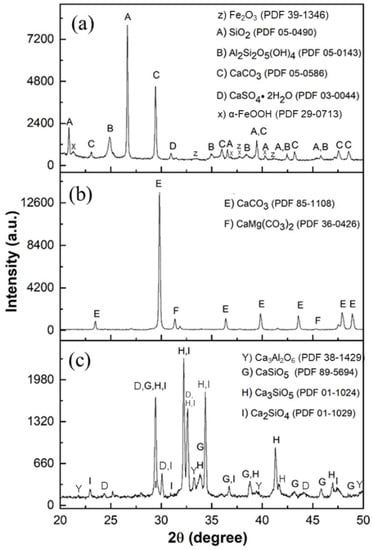
Figure 2.
XRD pattern of (a) natural lateritic soil, (b) asphalt waste dust and (c) the ordinary Portland cement (Type 1) used in this work.
The average particle size of asphalt waste dust was about 9.86 µm, which was consistent with the result of the sieving method. The plastic index of the asphalt waste dust cannot be determined since asphalt waste dust itself cannot be molded to evaluate the plastic limit. This ensures a non-plastic character and low water-holding capacity of asphalt waste dust. Asphalt waste dust included more than 80% CaO as its major component (Table 4). Highly detected CaO was associated with the existence of calcium carbonate (CaCO3) as the major composition, and the mineral dolomite (CaMg(CO3)2) as a minor detected composition (Figure 2b). These chemical and mineral compositions also confirmed it to be ab environmentally friendly material for recycling asphalt waste dust in many applications. Moreover, the XRD analysis of the asphalt waste dust revealed the highest reflection peak at 2θ degrees around 28.5˚, which corresponded to the (104) crystal plane. This reflection plane represented a rhombohedral calcite structure of CaCO3, which is the thermodynamically most stable form of CaCO3 at room temperature [18]. The morphological image in Figure 3 shows that the asphalt waste dust particles have a variable size distribution and an angular shape. However, the particle size was rather small, approximately below 10 µm, which was consistent with the findings of the laser particle size analysis.
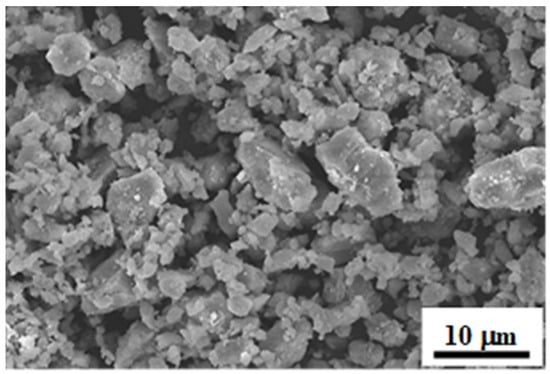
Figure 3.
Scanning electron microscopy (SEM) micrograph of as-received asphalt waste dust.
From Table 4, Portland cement is composed of 67.4 wt% CaO, 3.6 wt% Al2O3, 15.7 wt% SiO2, 3.2 wt% Fe2O3, and 10 wt% of other trace oxides, including MgO, MnO2, SO3, and K2O. The XRD patterns in Figure 2c reveals high CaO in the major-mineral forms of Dicalcium silicate (Ca2SiO4 or C2S), Tricalcium silicate (Ca3SiO5 or C3S), Tricalcium aluminate (Ca3Al2O6 or C3A), Calcium silicate oxide (CaSiO5), and Calcium sulfate or gypsum (CaSO4·2H2O) in Portland cement. These all components are well-known precursors of hydration reactions in the hydrated cement powder.
4.2. Compaction and Strength Characteristics
The compaction curve of the testing samples is shown in Figure 4. The compaction curves were determined three times repeatedly using a compaction test on the randomized LS, AD, 90LS-10AD, 80LS-20AD, 70LS-30AD, 90LS-10AD-5C, 80LS-20AD-5C, and 70LS-30AD-5C samples. The maximum dry density and the optimal water content of those samples exhibited a bell-shaped trend, in which the peak presented the maximum dry density at the optimal water content. From Figure 4, the highest average maximum dry density (2270 kg/m3) was observed in the pure lateritic soil or LS sample, whereas the lowest maximum dry density (1190 kg/m3) was obtained in the pure asphalt waste dust or AD sample. This is because the AD particle is both finer and lighter (high volume) than the LS particles. This is confirmed by some earlier studies [27,28] and the average particle size from the laser particle size analysis, as shown in Figure 5. Due to a poor water holding capacity, extra water needs to be absorbed into the spaces between the adjacent AD fine particles. As a result, the dry density cannot be as high as that of the LS particles. Moreover, the average maximum dry density of lateritic soil gradually decreased from 2270 kg/m3 to 1360 kg/m3 when the asphalt waste dust was replaced increasingly at the ratio of 10 wt%, 20 wt%, and 30 wt% in the LS samples. This also shows the descendent effect of asphalt waste dust on the reduction of maximum dry density.

Figure 4.
Compaction curve of the testing samples.
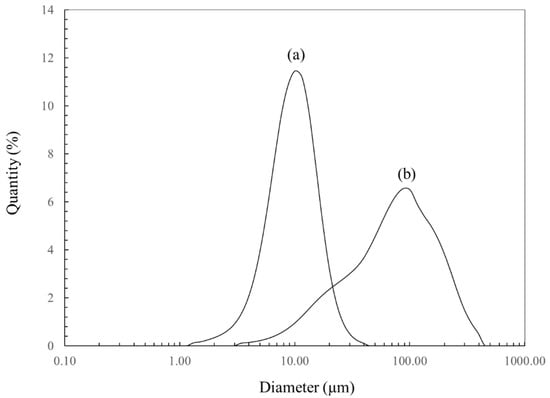
Figure 5.
Particle size distribution curves of (a) asphalt waste dust and (b) lateritic soil.
A more uniform distribution of finer AD particles in contrast to LS particles can be observed in the particle size distribution studied by the Laser particle diffraction technique in Figure 5. These characteristics easily provided dense packing without swelling, which results in a decrease in dry density [27,28]. On the contrary, a variety of large particle sizes in mixed-lateritic soil affected the maximum void ratio in the compacted samples [29]. This result confirmed that an increment of asphalt waste dust decreased the weight per unit volume and dry density of the LS samples, as seen in Figure 4. The average maximum dry density values of 90LS-10AD-5C, 80LS-20AD-5C, and 70LS-30AD-5C increased from 1360 kg/m3 to 2060 kg/m3, 2070 kg/m3, and 2050 kg/m3, respectively, when 5 wt% Portland cement was added to those lateritic soil-mixed samples. The maximum dry density of the 90LS-10AD-5C, 80LS-20AD-5C, and 70LS-30AD-5C samples were, however, still less than that of the original lateritic soil. This can be attributed to a slightly higher unit volume of cement mixtures than the original LS. Thus, a lower total weight per unit volume was obtained in these mixed samples, similar to the earlier report by Mohanty et al. (2017) [14].
According to Figure 4, lateritic soil and asphalt waste dust have an average optimal water content of 10.22% and 15.00%, respectively. The replacement lateritic soil samples with asphalt waste dust showed comparable optimal water content to that of original lateritic soil, which was not much different among them (90LS-10AD = 10.50%, 80LS-20AD = 10.70%, 70LS-30AD = 10.90%, 90LS-10AD-5C = 10.20%, 80LS-20AD-5C = 10.90%, and 70LS-30AD-5C = 10.80%). The relatively high optimal water content of the asphalt waste dust sample was due to a higher surface area of fine particles (average size ~9.86 µm) that required high water absorption. In addition, higher optimal water content was also associated with a lower maximum dry density in the asphalt waste dust sample, as reported by Pongsivasathit et al. (2019) [30].
In Figure 6, the California bearing ratio, or CBR, along with the swelling index value, show the strength characteristics of all tested of the samples. The randomized soil samples were subjected to experimental testing three times each. The CBR values of the original lateritic soil and asphalt waste dust under the soaked conditions were 14 and 79%, respectively. A higher CBR was found in the samples of asphalt waste dust compared to lateritic soil because the asphalt waste dust particles were smaller. The Thailand Department of Highways’ standard specifications for pavement materials (Table 3) show that the CBR value of asphalt waste dust is high enough to be used as a subbase course material in road construction. Moreover, the low CBR of the lateritic soil sample was related to the high water adsorption and high plasticity of lateritic soil under the soaked conditions, leading to a high shrinkage under the dry condition and high swelling under the wet condition [1,31].
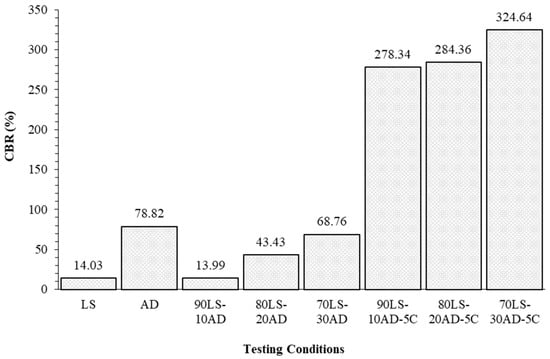
Figure 6.
CBR under soaked condition.
According to Figure 6, the CBR of 90LS-10AD, 80LS-20AD, and 70LS-30AD samples without cement addition were 14%, 43%, and 69%, respectively. There was no remarkable improvement with a 10 wt% addition of asphalt waste dust to the lateritic soil. By further increasing the asphalt waste dust from more than 10 wt% to 30 wt%, the CBR values were enhanced over the standard requirement of the subbase course material (≥25%). However, the obtained CBR values were in the range between those of pure lateritic soil and asphalt waste dust samples. This is probably because the fine asphalt waste dust and the lateritic soil particles were rearranged, increasing the stability and compactness of the mixed samples.
Those lateritic soil-mixed asphalt waste dust samples with 5 wt% cement added significantly 10-times increased the CBR to 278%, 284%, and 325% for 90LS-10AD-5C, 80LS-20AD-5C, and 70LS-30AD-5C samples, respectively (Figure 6). With only 5 wt% cement addition, the CBR of the lateritic soil-mixed asphalt waste dust samples was evidently improved through a hydration reaction between the Portland cement and water in the soil-mixed asphalt waste dust samples [32]. The products from this reaction were calcium silicate hydrate (C-S-H) and calcium aluminate hydrate (C-A-H) compounds, which acted as the “glue” between the adjacent soil and fine asphalt waste dust particles. C-S-H and C-A-H glues provided more compaction and reduced water permeability and soil swelling, resulting in an increase in strength. The fine asphalt waste dust also serves as a filler between the lateritic soil and Portland cement mixed particles at the same time. As a result, the lateritic soil mixes were compacted more tightly and minimized void or porosity in the compacted samples [18].
The CBR ≥ 25% of the lateritic soil mixes under the soaked conditions is required for use as a subbase course material according to the standard specifications of the Thailand Department of Highways. The CBR of lateritic soil and lateritic soil with 10% asphalt waste dust from this research were below the minimum criteria and were not appropriate for use as a subbase course material. As a result, the asphalt waste dust > 10 wt% was suggested in a replacement of lateritic soil samples in this work. According to Figure 6, the CBR of the 80LS-20AD sample (43.43%) and the 70LS-30AD sample (CBR 69%) were above the standard value, indicating that a minimum amount of 20 wt% of asphalt waste dust is required in lateritic soil mixtures to be suitable as a subbase course material.
The addition of small cement content further improved the CBR value. The extremely high CBR values from 278% to 325% were achieved in the 90LS-10AD-5C, 80LS-20AD-5C, and 70LS-30AD-5C samples. Without using the asphalt waste dust and other additive materials, several earlier works have reported a CBR below 200% for natural soil stabilized by Portland cement [9,11,12]. Therefore, the CBR values of 90LS-10AD-5C, 80LS-20AD-5C, and 70LS-30AD-5C samples in this work were much higher than those references. This indicated a capability of asphalt waste dust in lateritic soil stabilization with a small cement content.
The properties of all of the tested soil samples are summarized and presented in Table 5. In addition to the CBR value, the swelling index is also important to consider the suitable subbase course material when the road undergoes both dry conditions and wet conditions. According to Table 5, the swelling indexes of the lateritic soil samples, both with and without asphalt waste dust and cement, were in the range of 0.25–1.21%. All the swelling index obtained from the tested samples was all within acceptable limits for a subbase course material in accordance with the standard specifications of the Thailand Department of Highways (swelling index ≤ 4%), even though the values were somewhat variable with the asphalts waste dust content due to the high water absorption of fine dust.

Table 5.
The properties for all conditions.
Table 5 also shows the comparison of the liquid limit and plasticity index values of the testing samples. According to the Department of Highways’ specification of subbase course material, the minimum requirements of liquid limit and plasticity index are ≤35% and ≤11%, respectively. Only the liquid limit and plasticity index values of pure asphalt waste dust cannot be evaluated because of the non-plastic behavior of the waste dust. Meanwhile, all of the stabilized lateritic soil samples showed very acceptable liquid limit values (31–33%) under the minimum standard requirement.
On the contrary, the plasticity index values of lateritic soil samples, both with and without asphalt waste dust, were relatively higher than the accepted standard values. This contributed to the high plasticity of the original lateritic soil, although the non-plastic asphalt waste dust was partially replaced in the soil samples. However, the plasticity index values of the soil samples with increased asphalt waste dust can be further improved to find the standard requirement by cement addition (≤11 for Subbase course of DOH, 1989a). This was likely because the plasticity of lateritic soil was diminished by the hardening effect between cement and water [33]. Hence, the accepted plasticity index values of 11.30%, 10.33%, and 10.75% were obtained for the 90LS-10AD-5C, 80LS-20AD-5C, and 70LS-30AD-5C samples, respectively. The above findings suggested that the physical and mechanical properties of lateritic soil replaced with asphalt waste dust containing small amounts of cement could meet standard criteria for use as a subbase course material in road construction.
4.3. Microstructures and Relevant Phases of Compacted Samples
4.3.1. Microstructures of the Lateritic Soil and Asphalt Waste Dust Samples
The microstructures of the soaked lateritic soil and asphalt waste dust samples after the CBR test are shown in Figure 7. A loose-packed surface was observed for the pure lateritic soil sample (Figure 7a,c) compared to a denser compacted surface of the pure asphalt waste dust sample (Figure 7b,d). This was attributed to the large particle size and non-uniform distribution of soil particles, as previously shown in Figure 5. However, the compacted asphalt waste dust sample was still brittle compared to the other mixed samples, indicating that a non-plastic material such as asphalt waste dust could be utilized in certain strengthening projects.
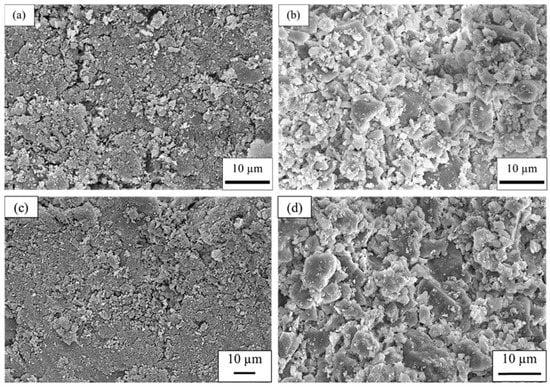
Figure 7.
Microstructures of the soaked lateritic soil (a,c) and asphalt waste dust samples (b,d) after CBR test.
The microstructures of the soaked lateritic soil-mixed asphalt waste dust samples after the CBR test are shown in Figure 8. The surface of the 90LS-10AD sample was found to be better compacted with 10 wt% asphalt waste dust (Figure 8a,b). This was influenced by the filling effect of fine asphalt waste dust in compacted soil particles. However, 10 wt%-asphalt waste dust was not enough to improve the strength of the lateritic soil, and therefore the CBR values and the overall microstructure of the 90LS-10AD samples were almost the same as the compacted pure lateritic soil samples (Figure 7a,c). When increasing the asphalt waste dust to 20 wt% in the lateritic soil mixes, the microstructure of the compacted 80LS-20AD samples resembled that of the compacted non-plastic materials. The small crevasses were observed in between the clusters of compacted particles (Figure 8c,d).
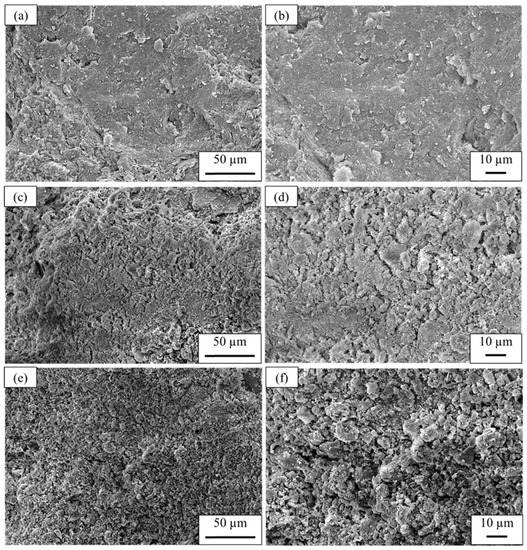
Figure 8.
Microstructures of the soaked lateritic soil-mixed asphalt waste dust samples after CBR test: (a,b) 90LS-10AD (c,d) 80LS-20AD, and (e,f) 70LS-30AD samples.
However, the 20 wt% of fine asphalt waste dust better improved the strength of lateritic soil than that of the 10 wt% asphalt waste dust. The CBR of the 80LS-20AD samples was thus higher than that of the 90LS-10AD samples. With 30 wt% of asphalt waste dust (Figure 8e,f), the microstructure of the compacted 70LS-30AD samples looks very similar to the singly compacted asphalt waste dust samples. The CBR values, which were comparable between those two samples, agreed with this. However, compared to the 90LS-10AD and 80LS-20AD samples, the CBR of the compacted 70LS-30AD sample was higher. This finding confirmed that a 30 wt% replacing amount of asphalt waste dust in the lateritic soil can improve the physical and mechanical properties over those of the original lateritic soil.
4.3.2. Microstructures of the Lateritic Soil-Mixed Asphalt Waste Dust and Portland Cement
Figure 9 shows the microstructures of the soaked lateritic soil-mixed asphalt waste dust with the addition of 5 wt% Portland cement. With the presence of a small amount of cement, the lateritic soil-mixed asphalt waste dust samples were much more compacted than the other samples with none of the cement. Especially in the sample with higher asphalt waste dust, the compactness was much more developed with the addition of cement powder. As seen in Figure 9e,f, a very dense surfaces without porosity and air voids were achieved in the 70LS-30AD-5C samples compared to the other samples in Figure 9a–d. According to Table 5, the plasticity index values of the lateritic soil samples with increasing asphalt waste dust were improved by the cement addition (≤11 for the subbase course of DOH [19]). This was attributed to the development of stiffness in those lateritic soil samples due to the reaction between cement and water, and thus deteriorated soil plasticity [33]. The filler-like properties of fine asphalt waste dust also promoted the compacted area for the complete hydration process and increased the cohesiveness and uniformity of the lateritic soil samples. Fine asphalt waste dust could physically disperse cement particles, thus freeing more water to react with cement powder [18]. Moreover, the fine asphalt waste dust was able to fill the air voids and reduced the inter-particle fraction of compacted soil to increase the soil strength. As shown in Figure 6, the CBR values of the 70LS-30AD-5C sample were much highly improved, and a very high compact microstructure was achieved, as demonstrated in Figure 9e,f. It was implied that the presence of fine asphalt waste dust with a small amount of cement could simultaneously promote particle packing and hardening effect between the lateritic soil and cement in the 70LS-30AD-5C samples.
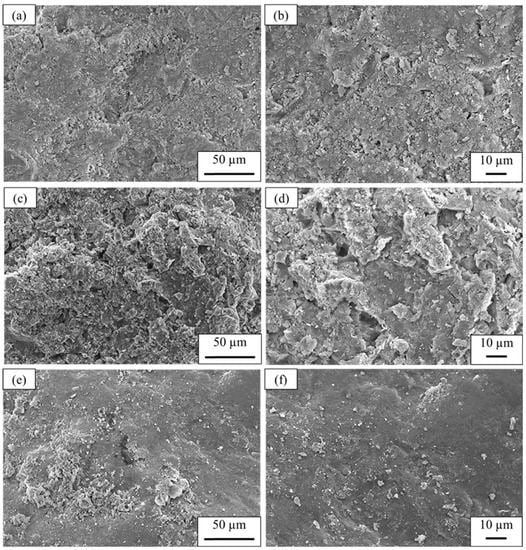
Figure 9.
Microstructures of the soaked lateritic soil-mixed asphalt waste dust containing Portland cement samples after CBR test: (a,b) 90LS-10AD-5C (c,d) 80LS-20AD-5C, and (e,f) 70LS-30AD-5C samples.
4.3.3. Relevant Phases of Compacted Lateritic Soil-Mixed Asphalt Waste Dust and Portland Cement
Figure 10 shows the XRD patterns of 70LS-30AD-5C and 70LS-30AD samples in comparison to the pure asphalt waste dust and lateritic soil samples after the CBR test. According to Figure 10a, the broad 2θ range between 20° to 50° is presented the difference in mineral phases in the compacted 70LS-30AD-5C and 70LS-30AD samples compared with the pure lateritic soil and pure asphalt waste dust samples after the CBR test. Generally, the parent phases in both original lateritic soil and the asphalt waste dust were observed in both the 70LS-30AD-5C and 70LS-30AD samples, as seen in the reflection peaks in Figure 10(a1,a2), respectively. From Figure 10a, the narrow 2θ range between 24˚ to 31˚ was focused on three main peaks; 2θ ~ 24.8˚ of kaolinite (K), 2θ ~ 26.6˚ of SiO2 or Quartz (Q), and 2θ ~ 28.5˚–29.5˚ of calcite or CaCO3 (C1 and C2 peaks) in the original lateritic soil compared with asphalt waste dust and presented in Figure 10b. The CaCO3 phase was reduced in the soaked 70LS-30AD-5C samples compared to the 70LS-30AD samples (Figure 10b1). This was attributed to the filler effect of fine asphalt waste dust containing CaCO3 that promoted the hydration of the Tricalcium silicate (C3S) major phase in cement [34]. Furthermore, very fine CaCO3 particles reacted with the Tricalcium aluminate (C3A) minor phase in cement to form a Carboaluminate. This phase partially took part in the Ettringite of cement hydration products and increased the early strength of the cement mixed samples [18]. Therefore, compared to the 70LS-30AD samples, the CBR values of the 70LS-30AD-5C samples were much greater.
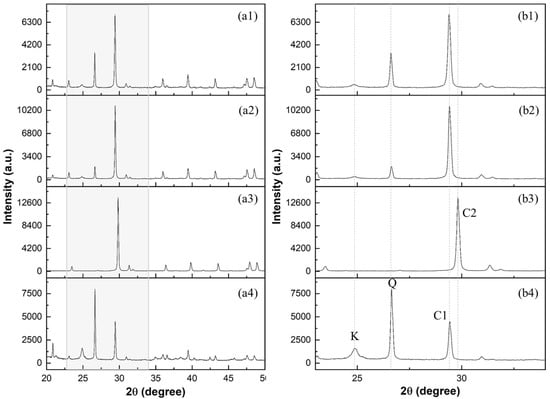
Figure 10.
XRD pattern of (a1,b1) 70LS-30AD-5C and (a2,b2) 70LS-30AD samples in comparison to (a3,b3) asphalt waste dust and (a4,b4) lateritic soil samples after CBR test: (a) the broad 2θ range = 20–50˚ and (b) the narrow 2θ range = 24–31˚ (K = kaolinite (PDF 05-0143), Q = Quartz (PDF 05-0490), C1 = Calcite (PDF 05-0586), and C2 = Calcite (PDF 85-1108)).
To confirm the above finding, the amount of the CaCO3 or calcite phase in both the 70LS-30AD-5C and 70LS-30AD samples was evaluated by Equation (3), based on the theory reported earlier by Ebadzadeh and Ghasemi (2002) [35] and Imane et al. (2020) [36]. IC and IQ are, respectively, the peak intensities of calcite at 2θ = 28.5˚ and quartz at 2θ = 26.6˚ that are used to estimate the calcite phase in the soaked 70LS-30AD-5C and the 70LS-30AD samples. Using Equation (3) and peak intensities from Figure 10(b1,b2), the calcite crystalline phase in the soaked 70LS-30AD was calculated to be 86.06%; meanwhile, the calcite crystalline phase in the soaked 70LS-30AD-5C was reduced to 67.36%. This confirmed that the CaCO3 from the asphalt waste dust partially reacted with the chemical components in cement powder during the hydration reaction and finally increased the strength of the mixed lateritic soil samples.
Calcite crystalline phase = IC/(IC + IQ) × 100
5. Conclusions and Recommendations
This study proposes asphalt waste dust as a sustainable material to improve the strength of low-quality lateritic soil used as a subbase course material for road construction. Based on the results, the following conclusions and recommendations can be made:
- The asphalt waste dust itself can be used as a subbase course material in road structure according to the standard specifications of pavement materials from the Thailand Department of Highways.
- The minimum 20 wt% asphalt waste dust was suggested for a sufficiently high California bearing ratio and optimized plastic index, liquid limit, and swelling index of stabilized lateritic soil above the standard requirement of subbase course materials.
- The fine particles of asphalt waste dust show filler-like properties to reduce the voids and generate a very dense surface without porosity in the strengthening lateritic soil.
- A partial reaction of the CaCO3 phase in asphalt waste dust with the chemical components in cement reduced the calcite phase in the stabilized-soil samples containing asphalt waste dust, resulting in highly developed CBR in the stabilized-soil samples above the standard of the subbase course to achieve the base course material requirements.
- The stabilized soil samples containing asphalt waste dust and a small amount of cement dust were recommended to further use as the base course material instead of natural crush rock.
Finally, this research demonstrated that the recycling-asphalt waste dust from asphalt concrete manufacturing is a novel additive filler with highly effective performance to improve low-quality lateritic soil for construction purposes as an effectively sustainable subbase course and base course materials for further generation in road construction purposes.
Author Contributions
Conceptualization, S.C. and J.A.; methodology and experiments, S.C. and P.S.; data analysis, S.C. and J.A.; data curation, S.C. and J.A.; writing—original draft preparation, S.C.; writing—review and editing, S.C. and J.A.; supervision, S.C.; project administration, S.C.; funding acquisition, J.A. All authors have read and agreed to the published version of the manuscript.
Funding
This research was financially supported by Suranaree University of Technology (SUT) Research and Development Fund.
Institutional Review Board Statement
Not applicable.
Informed Consent Statement
Not applicable.
Data Availability Statement
The data presented in this study are available on request from the corresponding author.
Acknowledgments
The work was supported by Suranaree University of Technology (SUT) Research and Development Fund, and Thailand Science Research and Innovation (TSRI). The King Mongkut’s Institute of Technology Ladkrabang is also highly appreciated.
Conflicts of Interest
The authors declare no conflict of interest.
References
- Ogbuagu, F.U.; Okeke, C.A.U. Geotechnical properties of lateritic soil from Nimo and Nteje areas of Anambra State, Southeastern Nigeria. In Proceedings of the 1st International Conference on Sustainable Infrastructural Development, Ota, Nigeria, 24–28 June 2019. [Google Scholar]
- Chaiyaput, S.; Ayawanna, J. Stabilization of lateritic soil by ladle furnace slag for pavement subbase material. Geomech. Eng. 2021, 26, 323–331. [Google Scholar] [CrossRef]
- Lemougna, P.N.; Melo, U.F.C.; Kamseu, E.; Tchamba, A.B. Laterite Based Stabilized Products for Sustainable Building Applications in Tropical Countries: Review and Prospects for the Case of Cameroon. Sustainability 2011, 3, 293–305. [Google Scholar] [CrossRef] [Green Version]
- Chaiyaput, S.; Bergado, D.T.; Ayawanna, J. Effect of polymer and Portland cement on strengthen crushed rock for pavement base. J. Lowl. Technol. Int. 2019, 21, 134–142. [Google Scholar]
- Chaiyaput, S.; Manandhar, S.; Karki, S.; Ayawanna, J. Characteristics of cement treated soil: A case study from soft Bangkok clay and red soil of Nepal. J. Lowl. Technol. Int. 2020, 22, 178–191. [Google Scholar] [CrossRef]
- Horpibulsuk, S.; Sirilerdwattna, W.; Rachan, R.; Katkan, W. Analysis of strength development in pavement stabilization: A field investigation. In Proceedings of the 16th Southeast Asian Geotechnical Conference, Subang Jaya, Malaysia, 8–11 May 2007; pp. 579–583. [Google Scholar]
- Sunitsakul, J.; Sawatparnich, A. Statistical model to predict unconfined compressive strength of soil–cement materials. In Proceedings of the 13th National Convention on Civil Engineering, Pattaya, Thailand, 14–16 May 2008. [Google Scholar]
- Jaritngam, S.; Prachasaree, W.; Somchainuek, O.; Taneerananon, P. An investigation of lateritic soil cement for sustainable pavements. Indian J. Sci. Technol. 2012, 5, 3603–3606. [Google Scholar] [CrossRef]
- Promputthangkoon, P.; Kanchanachetance, B. Compound soil-tyre chips modified by cement as a road construction material. Songklanakarin J. Sci. Technol. 2013, 35, 579–587. [Google Scholar]
- Marathe, S.; Kumar, A.; Avinash. Stabilization of lateritic soil subgrade using cement, coconut coir and aggregates. Int. J. Innov. Res. Sci. Eng. Technol. 2015, 4, 11907–11914. [Google Scholar] [CrossRef]
- Afolayan, O.D. Evaluation of the effect of lime and cement on the engineering properties of selected soil in a university in Southwestern Nigeria. J. Adv. Eng. Technol. 2017, 5. [Google Scholar] [CrossRef]
- Komolafe, O.O.; Osinubi, K.J. Stabilization of lateritic soil with cement—Oil palm empty fruit bunch ash blend for California bearing ratio base course requirement. IOP Conf. Ser. Mater. Sci. Eng. 2019, 640, 012085. [Google Scholar] [CrossRef]
- Oyediran, I.A.; Kalejaiye, M. Effect of increasing cement content on strength and compaction parameters of some lateritic soils from Southwestern Nigeria. Electron. J. Geotech. Eng. 2011, 16, 1501–1514. [Google Scholar]
- Mohanty, S.K.; Pradhan, P.K.; Mohanty, C.R. Stabilization of expansive soil using industrial wastes. Géoméch. Eng. 2017, 12, 111–125. [Google Scholar] [CrossRef]
- Amadi, A. Evaluation of changes in index properties of lateritic soil stabilized with fly ash. Leonardo Electron. J. Pract. Technol. 2010, 9, 69–78. [Google Scholar]
- Mahajan, S.M.; Parbat, D.K. Effects of fly ash on engineering properties of BC soil. Int. J. Sci. Eng. Res. 2015, 1, 7–12. [Google Scholar]
- Gudissa, W.; Dinku, A. The use of limestone powder as an alternative cement replacement material: An experimental study. Zede J. 2010, 27, 23–43. [Google Scholar]
- Ali, M.; Abdullah, M.S.; Saad, S.A. Effect of Calcium Carbonate Replacement on Workability and Mechanical Strength of Portland Cement Concrete. Adv. Mater. Res. 2015, 1115, 137–141. [Google Scholar] [CrossRef]
- Department of Highways (DOH), Standard no. DH-S 205/2532. 1989. Available online: http://www.doh.go.th/doh/images/aboutus/standard/01/dhs205-32.pdf (accessed on 12 February 2021).
- Ruedeeviroj, S.; Duangdeun, P. Effect of gradation and fine perticels in soil mass on engineering properties of lateritic soil mixed with fly ash. In Proceedings of the 10th National Convention on Civil Engineering, Engineering Institute of Thailand, Pattaya, Thailand, 2–4 May 2005. [Google Scholar]
- AASHTO T 180; Standard Method of Test for Moisture-Density Relations of Soils Using a 4.54-kg (10-lb) Rammer and a 457-mm (18-in.) Drop. American Association of State Highway and Transportation Officials: Washington, DC, USA, 2017.
- AASHTO T 193; Standard Method of Test for the California Bearing Ratio. American Association of State Highway and Transportation Officials: Washington, DC, USA, 2017.
- Department of Highways (DOH), Standard No. DH-S 201/2544. 2001. Available online: http://www.doh.go.th/doh/images/aboutus/standard/01/dhs201-44.pdf (accessed on 12 February 2021).
- Department of Highways (DOH), Standard No. DH-S 208/2532. 1989. Available online: http://www.doh.go.th/doh/images/aboutus/standard/01/dhs208-32.pdf (accessed on 12 February 2021).
- Department of Highways (DOH), Standard No. DH-S 209/2532. 1989. Available online: http://www.doh.go.th/doh/images/aboutus/standard/01/dhs209-32.pdf (accessed on 12 February 2021).
- Department of Highways (DOH), Standard No. DH-S 102/2532. 1989. Available online: http://www.doh.go.th/doh/images/aboutus/standard/01/dhs102-32.pdf (accessed on 12 February 2021).
- Das, B.M. Fundamental of Geotechnical Engineering; Thomson Learning: Belmont, CA, USA, 2000. [Google Scholar]
- Marco, P.; Andrea, B.; Emiliano, P.; Marta, S.; Vanesa, O.-L. Performance-based characterization of bituminous mortars prepared with ladle furnace steel slag. Sustainability 2020, 12, 1777. [Google Scholar] [CrossRef] [Green Version]
- Chaney, R.; Demars, K.; Lade, P.; Liggio, C.; Yamamuro, J. Effects of Non-Plastic Fines on Minimum and Maximum Void Ratios of Sand. Geotech. Test. J. 1998, 21, 336–347. [Google Scholar] [CrossRef]
- Pongsivasathit, S.; Horpibulsuk, S.; Piyaphipat, S. Assessment of mechanical properties of cement stabilized soils. Case Stud. Constr. Mater. 2019, 11, e00301. [Google Scholar] [CrossRef]
- Maignien, R. Review of Research on Laterites; United Nations Educational, Scientific and Cultural Organization: Paris, France, 1966. [Google Scholar]
- Parsons, R.L.; Milburn, J.P. Engineering Behavior of Stabilized Soils. Transp. Res. Rec. J. Transp. Res. Board 2003, 1837, 20–29. [Google Scholar] [CrossRef]
- Firoozi, A.A.; Guney Olgun, C.; Firoozi, A.A.; Baghini, M.S. Fundamentals of soil stabilization. Int. J. Geo-Eng. 2017, 8, 26. [Google Scholar] [CrossRef] [Green Version]
- Poudyal, L.; Adhikari, K.; Won, M. Mechanical and Durability Properties of Portland Limestone Cement (PLC) Incorporated with Nano Calcium Carbonate (CaCO3). Materials 2021, 14, 905. [Google Scholar] [CrossRef] [PubMed]
- Ebadzadeh, T.; Ghasemi, E. Effect of TiO2 addition on the stability of t-ZrO2 in mullite–ZrO2 composites prepared from various starting materials. Ceram. Int. 2002, 28, 447–450. [Google Scholar] [CrossRef]
- Daou, I.; Lecomte-Nana, G.; Tessier-Doyen, N.; Peyratout, C.; Gonon, M.; Guinebretiere, R. Probing the Dehydroxylation of Kaolinite and Halloysite by In Situ High Temperature X-ray Diffraction. Minerals 2020, 10, 480. [Google Scholar] [CrossRef]
Publisher’s Note: MDPI stays neutral with regard to jurisdictional claims in published maps and institutional affiliations. |
© 2022 by the authors. Licensee MDPI, Basel, Switzerland. This article is an open access article distributed under the terms and conditions of the Creative Commons Attribution (CC BY) license (https://creativecommons.org/licenses/by/4.0/).